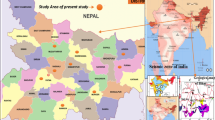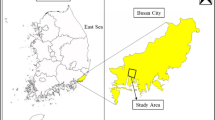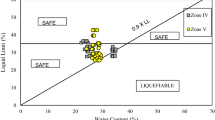Abstract
Liquefaction behavior of fine-grained soil is associated with numerous soil parameters; however, over the past few years, importance of plasticity in predicting liquefaction susceptibility of soil has been well established in the literature. Regardless of recent advancements, no evident correlation has been developed between plasticity of the soil and factors of safety against liquefaction. Henceforth, the present study evaluates the effect of plasticity on liquefaction behavior of fine-grained soil for seismically active regions of Bihar (India) by proposing an equation based on multi-linear regression (MLR) analysis for predicting factor of safety against liquefaction (FL). The results of the study are supported by reliability analysis (FOSM) which also establish a co-relation between FL, reliability index (β) and probability of liquefaction (PL). The validation of the results using real liquefaction data obtained from liquefied and non-liquefied sites of Chi-Chi earthquake in Taiwan as well as data from Indo-Gangetic plains has confirmed the consistency of the developed multi-linear regression equation. The study devices a substantial impact in the field of liquefaction prediction for fine-grained soil with moderate to high plasticity and aims to felicitate a significant contribution in the knowledge pool of liquefaction studies. The developed equation may also serve as a guideline for taking critical engineering decisions especially during preliminary design calculations of any civil engineering structures vulnerable to liquefaction.











Similar content being viewed by others
Abbreviations
- CSR:
-
Cyclic stress ratio
- CRR:
-
Cyclic resistance ratio
- FOS:
-
Factor of safety
- SPT:
-
Standard penetration test
- PGA:
-
Peak ground acceleration
- LL:
-
Liquid limit
- PI:
-
Plasticity index
- FC:
-
Fine content
- (N1)60 :
-
SPT blow count value
- Wc/LL:
-
Ratio of water content to liquid limit
- σvo :
-
Total vertical overburden pressure
- σ'vo :
-
Effective vertical overburden pressure
- rd :
-
Stress reduction factor
- amax :
-
Peak horizontal ground acceleration
- MSF:
-
Magnitude scaling factor
- Kσ:
-
Factor of effective overburden
- M:
-
Earthquake magnitude
- Z:
-
Depth
- FOSM:
-
First-order second moment
- R:
-
Resistance
- S:
-
Static
- Z:
-
Performance function
- µ:
-
Mean value
- σ:
-
Standard deviation
- β:
-
Reliability index
- Pf :
-
Probability of failure
- COV:
-
Coefficient of variation
- PDF:
-
Probability distribution function
- MLR:
-
Multi-linear regression
- FL :
-
Factor of safety against liquefaction
- PL :
-
Probability of liquefaction
- RMSE:
-
Root mean square error
- R:
-
Co-relation coefficient
- R2 :
-
Coefficient of determination
- VAF:
-
Variance account factor
- PI:
-
Performance index
- FA :
-
Actual values of factor of safety
- FP :
-
Predicted values of factor of safety
- FMEAN :
-
Mean values of factor of safety
References
Andrews, D. C. A., and Martin, G. R. (2000) Criteria for liquefaction of silty soils Proc., 12th World Conf. on Earthquake Engineering, Auckland, New Zealand.
A. Anwar, Y. Jamal, S. Ahmad, M.Z. Khan, Assessment of liquefaction potential of soil using multi-linear regression modeling. Int. J. Civ. Eng. Technol. 7(1), 373–415 (2016)
P.G. Asteris, A.D. Skentou, A. Bardhan, P. Samui, K. Pilakoutas, Predicting concrete compressive strength using hybrid ensembling of surrogate machine learning models. Cem. Concr. Res. 145, 106449 (2021)
G.L.S. Babu, A. Srivastava, Reliability analysis of allowable pressure on shallow foundation using response surface method. Comput. Geotech. 34(3), 187–194 (2007). https://doi.org/10.1016/j.compgeo.2006.11.002
G.S. Babu, V.P. Singh, Reliability analyses of a prototype soil nail wall using regression models. Geomech. Eng. 2(2), 71–88 (2010)
Bartlett, S. F., and Youd, T. L. (1992) ‘‘Empirical analysis of horizontal ground displacement generated by liquefaction-induced lateral spread.’’ Tech. Rep. No. NCEER-92–0021, National Centre for Earthquake Engineering Research, Buffalo, N.Y., 114.
S.F. Bartlett, T.L. Youd, Empirical prediction of liquefaction-induced lateral spread. J. Geotech. Eng. (1995). https://doi.org/10.1061/(ASCE)0733-9410(1995)121:4(316),316-329
R.W. Boulanger, I.M. Idriss, Liquefaction susceptibility criteria for silts and clays. J. geotech. Geoenviron. Eng. 132(11), 1413–1426 (2006)
J.D. Bray, R.B. Sancio, Assessment of the liquefaction susceptibility of fine grained soil. J. Geotech. Eng. 132(9), 1165–1177 (2006)
Bray, J.D., Sancio, R.B., Reimer, M.F. and Durgunoglu,,T. (2004), “Liquefaction Susceptibility of Fine-grained Soils”, Proc. 11th Int. Conf. on Soil Dynamics and Earthquake Engineering and 3rd Inter. Conf. on Earthquake Geotech. Engrg., Berkeley, CA, Jan. 7–9, Vol. 1, pp. 655–662.
F.C. Bungenstab, K.V. Bicalho, Settlement predictions of footings on sands using probabilistic analysis. J. Rock Mech. Geotech. Eng. 8(2), 198–203 (2016). https://doi.org/10.1016/j.jrmge.2015.08.009
Chang, N. Y., Yeh, S. T., & Kaufman, L. P. (1982, June). Liquefaction potential of clean and silty sands. In Proceedings of the third international earthquake micro-zonation conference (Vol. 2, pp. 1017–1032).
K. Chatterjee, D. Choudhury, Variations in shear wave velocity and soil site class in Kolkata city using regression and sensitivity analysis. Nat. Hazards 69(3), 2057–2082 (2013)
S. Ghani, S. Kumari, Insight into the effect of fine content on liquefaction behavior of soil. Geotech. Geol. Eng. 39(1), 1–12 (2021)
S. Ghani, S. Kumari, Liquefaction study of fine-grained soil using computational model. Innov. Infrastruct. Sol. 6(2), 1–17 (2021)
Ghani, S., & Kumari, S. (2021a). Liquefaction susceptibility of high seismic region of Bihar considering fine content. in Basics of Computational Geophysics. (Elsevier), pp. 105–120
I. Gratchev, K. Sassa, H. Fukuoka, How reliable is the plasticity index for estimating the liquefaction potential of clayey sands? J. Geotech. Geo-environ. Eng. 132(1), 124–127 (2006)
T. Guo, S. Prakash, Liquefaction of silts and silt-clay mixtures. J. Geotech. Geoenviron. Eng. 125(8), 706–710 (1999)
Harichane, Z., Erken, A., Ghrici, M., & Chateauneuf, A. (2018, November). Case Study of Reliability Liquefaction Analysis Based on Standard Penetration Test: Sakarya City (Turkey). In Conference of the Arabian Journal of Geosciences (pp. 213–215). Springer, Cham.
Harr, M. E. (1984). ‘‘Reliability-based design in civil engineering.’’ 1984 Henry M. Shaw Lecture, Dept. of Civil Engineering, North Carolina State University, Raleigh, N.C.
J.H. Hwang, C.W. Yang, Verification of critical cyclic strength curve by Taiwan Chi-Chi earthquake data. Soil Dyn. Earthq. Eng. 21(3), 237–257 (2001)
I.M. Idriss, R. Boulanger, Semi-empirical procedures for evaluating liquefaction potential during earthquakes. J. Soil Dyn. Earthq. Eng. 26(2), 115–130 (2006)
K. Ishihara, J. Koseki, Cyclic Shear Strength of Fines-Containing Sands (Japanese Society of Soil Mechanics and Foundation Engineering, Tokyo, Earthquake and Geotech. Engg., 1989), pp. 101–106
K. Ishihara, J. Troncoso, Y. Kawase, Y. Takahashi, Cyclic strength characteristics of tailings materials. Soils Found. 20(4), 127–142 (1980)
Janalizade, A., Naghizadehrokni, M., & Naghizaderokni, M. (2015, May). Reliability-based method for assessing liquefaction potential of soils. In 5th ECCOMAS Thematic Conference on Computational Methods in Structural Dynamics and Earthquake Engineering.
S.K. Jha, K. Suzuki, Reliability analysis of soil liquefaction based on standard penetration test. Comput. Geotech. 36(4), 589–596 (2008). https://doi.org/10.1016/j.compgeo.2008.10.004
S.K. Jha, K. Suzuki, Liquefaction potential index considering parameter uncertainties. Eng. Geol. 102(1–2), 55–60 (2009). https://doi.org/10.1016/j.enggeo.2009.03.012
R.B. Jishnu, S.P. Naik, N.R. Patra, J.N. Malik, Ground response analysis of Kanpur soil along Indo-Gangetic plains. Soil Dyn. Earthq. Eng. 51, 47–57 (2013)
Johari, A., Rahnema, H., Feilinejad, A., & Fotovat, A. (2020). A comparative study in reliability analysis of liquefaction potential of layered soil. In International Conference on Civil Engineering, Architecture, Development and Reconstruction of Urban Infrastructure.
W.B. Joyner, D.M. Boore, Methods for regression analysis of strong-motion data. Bull. Seism. Soc. Am. 83, 469–487 (1993)
C.H. Juang, J. Ching, Z. Luo, C.S. Ku, New models for probability of liquefaction using standard penetration tests based on an updated database of case histories. Eng. Geol. 133, 85–93 (2012). https://doi.org/10.1016/j.enggeo.2012.02.015
C.H. Juang, S.Y. Fang, D.K. Li, Reliability analysis of liquefaction potential of soils using standard penetration test, in Reliability-based design in geotechnical engineering, computers and applications. ed. by K.K. Phoon (Taylor & Francis, London, 2008)
C.H. Juang, D.V. Rosowsky, W.H. Tang, Reliability-based method for assessing liquefaction potential of soils. J. Geotech. Geoenviron. Eng. 125(8), 684–689 (1999)
N. Kardani, A. Bardhan, D. Kim, P. Samui, A. Zhou, Modelling the energy performance of residential buildings using advanced computational frameworks based on RVM, GMDH, ANFIS-BBO and ANFIS-IPSO. J. Build. Eng. 35, 102105 (2021)
N. Kardani, A. Bardhan, P. Samui, M. Nazem, A. Zhou, D.J. Armaghani, A novel technique based on the improved firefly algorithm coupled with extreme learning machine (ELM-IFF) for predicting the thermal conductivity of soil. Eng. Comput. (2021). https://doi.org/10.1007/s00366-021-01329-3
M.A. Khan, M.Z. Khan, M.B. Khan, Effect of fines on liquefaction resistance in fine sand and silty sand. Int. J. Eng. Res. Appl. 6(1), 102–106 (2016)
M. Kumar, A. Bardhan, P. Samui, J.W. Hu, R. Kaloop, M. , Reliability analysis of pile foundation using soft computing techniques: a comparative study. Processes 9(3), 486 (2021)
G.M. Latha, A. Somwanshi, K.H. Reddy, A multiple regression equation for prediction of bearing capacity of geosynthetic reinforced sand beds. Indian Geotech. J. 43, 331–343 (2013). https://doi.org/10.1007/s40098-013-0053-7
S.S.C. Liao, D. Veneziano, R.V. Whitman, Regression models for evaluating liquefaction probability. J. Geotech. Engrg 114(4), 389–411 (1988)
Marto, A;Tan, C S; M Akhtar, A M; Ung S W and Lim, M Y, , Effect of plasticity on liquefaction susceptibility of sand-fines mixtures. Appl. Mech. Mater. 773–774, 1407–1411 (2015)
Miura, S., Yagi, K., & Kawamura, S. (1995). Liquefaction damage of sandy and volcanic grounds in the 1993 Hokkaido Nansei-Oki earthquake.
Naik, S. P., Patra, N. R., & Malik, J. N. (2012). Assessment of liquefaction potential of alluvial soil of Indo-Gangetic Interfluves, Northern India. In GeoCongress 2012: State of the Art and Practice in Geotechnical Engineering (pp. 1859–1868).
Nilay, N., & Chakrabortty, P. (2021). Evolution in liquefaction strength of Ganga river sand due to intrusion of non-plastic silt. In Geohazards (pp. 283–297). Springer, Singapore.
Perlea, V. G. (2000). Liquefaction of cohesive soils. In Soil Dynamics and Liquefaction 2000 (pp. 58–76).
Phoon, K. K. (Ed.). (2008). Reliability-based design in geotechnical engineering: computations and applications. CRC Press.
K.K. Phoon, F.H. Kulhawy, Characterization of geotechnical variability. Can. Geotech. J. 36(4), 612–624 (1999)
Polito C., (2001) Plasticity based liquefaction criteria, Proc. of the 4th intl. Conf. on recent advances in geotechnical earthquake engineering and soil dynamics.
S. Prakash, J.A. Sandoval, Liquefaction of low plasticity silts. J. Soil Dyn. Earthq. Eng. 71(7), 373–397 (1992)
Puri, V. K. (1984). Liquefaction behavior and dynamic properties of loessial (silty) soils (Doctoral dissertation, University of Missouri-Rolla).
Puri, V. K. (1990). Liquefaction aspects of loessial soils. In Proceeding 4th US National Conference on Earthquake Engineering, Earthquake Engineering Research Institute, El Cerito, California (Vol. 3, pp. 755–762).
Sandoval, J. (1989). Liquefaction and settlement characteristics of silt soils, PhD Dissertation, University of Missouri–Rolla, Mo.
Seed, B., & Lee, K. L. (1966). Liquefaction of saturated sands during cyclic loading. Journal of Soil Mechanics & Foundations Div, 92(ASCE# 4972 Proceeding).
Seed, H. B., and Idriss, I. M. (1971). Simplified procedure for evaluating soil liquefaction potential. J. Soil Mech. Found. Div., ASCE, 97, SM8, pp. 1249–1274.
Seed, H. B., and Idriss, I. M. (1982). Ground motions and soil liquefaction during earthquakes, Berkeley,Calif: Earthquake Engineering Research Institute
Seed, R.B., Cetin, K.O., Moss, R.E.S., Kammerer, A.M., Wu J., Pestana J.M., Riemer M.F., Sancio R.B., Bray J.D., Kayen R.E., Faris A. (2003) Recent advances in soil liquefaction engineering: A unified and consistent framework, EERC-2003–06, Earthquake Engineering Research Institute, Berkeley, California.
Seed,R.B, K.O. Cetin, and R.E.S. Moss (2001), Recent Advances in Soil Liquefaction Hazard Assessment, 15th ICSMGEG, TC4 satellite conference on Lessons Learned from Recent Strong Earthquakes, Istanbul, Turkey.
Shahu, J. T., & Mohanty, M. (2020). Ground Modification Techniques to Improve Liquefaction Resistance in Indo-Gangetic Soils. In Geotechnics for Natural Disaster Mitigation and Management (pp. 127–133). Springer, Singapore.
A.S. Thakur, S. Pandya, A. Sachan, Dynamic behavior and characteristic failure response of low plasticity cohesive soil. Int. J. Civ. Eng. 19(2), 167–185 (2021)
S.K. Umar, P. Samui, S. Kumari, Deterministic and probabilistic analysis of liquefaction for different regions of Bihar. Geotechnical and Geological Engineering, Springer, Published online 36(5), 3311–3321 (2018)
Uzielli, M., Duzgun, S., & Vangelsten, B. V. (2006). A first-order second-moment framework for probabilistic estimation of vulnerability to landslides. Engineering Conferences International.
R. Varghese, M.S. Amuthan, A. Boominathan, S. Banerjee, Cyclic and postcyclic behaviour of silts and silty sands from the Indo Gangetic Plain. Soil Dyn. Earthq. Eng. 125, 105750 (2019)
M. Vucetic, R. Dobry, Degradation of marine clays under cyclic loading. J. Geotech. Eng. 114(2), 133–149 (1988)
W. Wang, (1979) Some Findings in Soil Liquefaction. Report Water Conservancy and Hydro-electric Power Scientific Research Institute, Beijing, China, 1–17.
Yegian, M., and Whitman, R. V. (1978). "Risk analysis for ground failure by liquefaction." / . Geotech. Engrg. Div., ASCE, 104 (GT7), 921–938.
Youd T.L (1998), Screening guide for rapid assessment of liquefaction hazard at highway bridge sites. MCEER-98–0005
T.L. Youd, Application of MLR procedure for prediction of liquefaction-induced lateral spread displacement. J. Geotech. Geoenviron. Eng. 144(6), 04018033 (2018)
T.L. Youd, C.M. Hansen, S.F. Bartlett, Revised multilinear regression equations for prediction of lateral spread displacement. J. Geotech. Geoenviron. Eng. (2002). https://doi.org/10.1061/(ASCE)1090-0241(2002)128:12(1007),1007-1017
Funding
Not Applicable.
Author information
Authors and Affiliations
Corresponding author
Ethics declarations
Conflict of interest
The authors declare that they do not have any conflict of interest.
Additional information
Publisher's Note
Springer Nature remains neutral with regard to jurisdictional claims in published maps and institutional affiliations.
Appendices
Appendix 1
See Table
8,
9,
10,
Appendix 2
See Table
Rights and permissions
About this article
Cite this article
Ghani, S., Kumari, S. Probabilistic Study of Liquefaction Response of Fine-Grained Soil Using Multi-Linear Regression Model. J. Inst. Eng. India Ser. A 102, 783–803 (2021). https://doi.org/10.1007/s40030-021-00555-8
Received:
Accepted:
Published:
Issue Date:
DOI: https://doi.org/10.1007/s40030-021-00555-8




